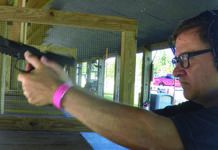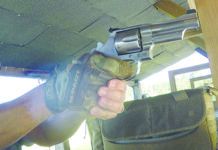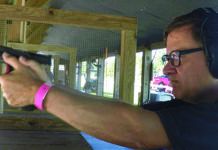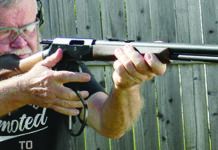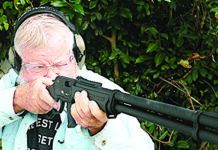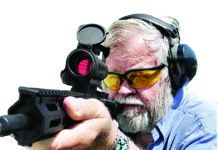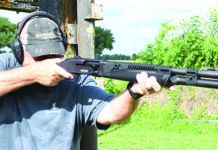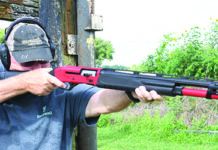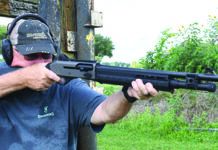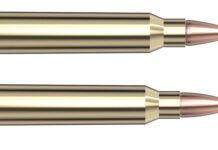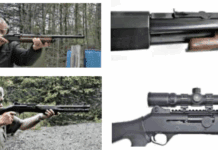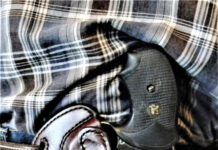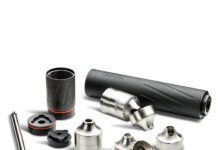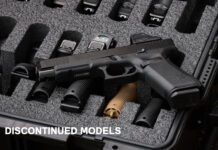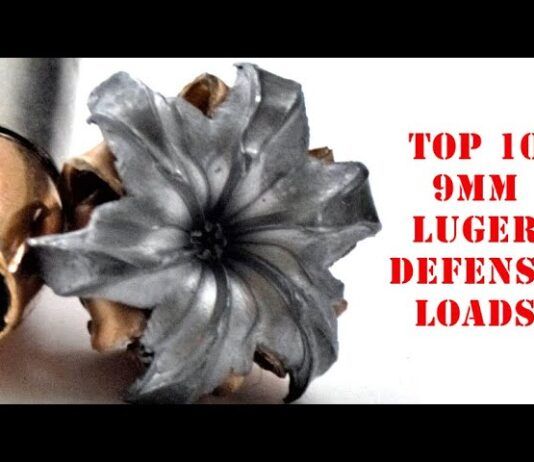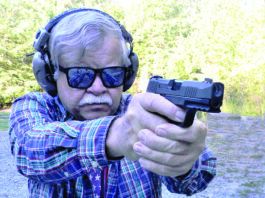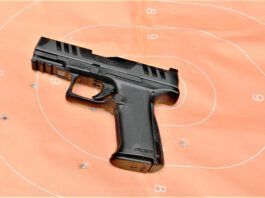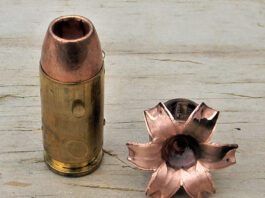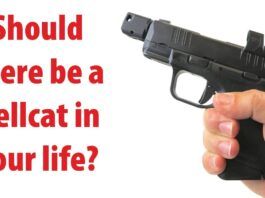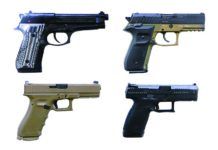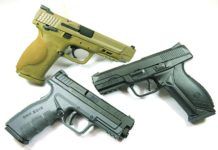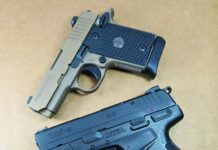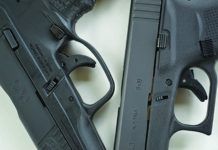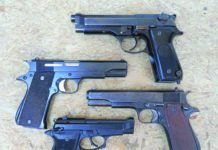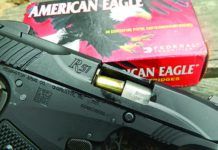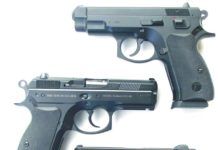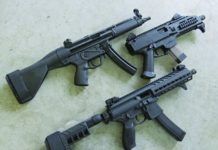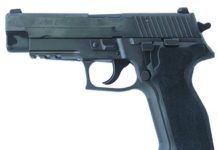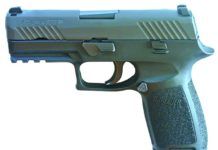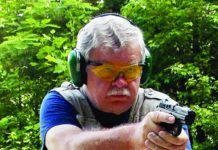Service-Sized 9mm Handguns Shoot It Out for Carry Honors
We recently tested a quartet of 9mm-chambered full-size firearms suitable for daily carry: the Lipsey's Glock 17RTF2 Vickers FDE based on the Glock 17, a Beretta 92FS with Wilson Combat upgrades, an Arex Rex Zero 1 Standard, and a CZ-USA CZ P-10 C. Each one could be thrown into any mix of handguns and do well. But there are specific differences that will make one pistol or another preferable for an individual, and that is what this shoot out is all about.
Full-size 9mm handguns have an impressive reserve of ammunition, they handle recoil well, and offer real power with +P loads. For home defense, a 14- to 18-shot 9mm handgun is effective, perhaps the best all-round home-defense handgun for a trained shooter. In this test, each pistol is an example of a popular carry gun as well, with many shooters concealing a Glock 17 or even a Beretta 92FS for daily carry. Here, all had faultless reliability, which is a prerequisite for a defense firearm in our testing. We also learned the Lipsey's/Vickers Glock gave excellent results on the combat course, and the Wilson Combat-upgraded Beretta aced the field in accuracy. We trust these pistols, but only one was the best performer overall for our shooters. For certain preferences and duties, each has advantages, which we note in detail below.
All handguns tested for personal defense must be proven on the firing range. We tested two examples of upgraded service pistols. A special-run RTF texture Glock 17 from distributor Lipsey's has a Vickers Tactical package added to it, with components suggested by or supplied by well-known trainer Larry Vickers. Likewise, we tested a Beretta 92FS updated with Wilson Combat parts. The results for both are better range performance, especially when performing rapid magazine changes because each package features a magazine guide and magazine base pads.
We matched the Glock and Beretta against the new CZ P-10 C, a polymer-frame striker-fired pistol, and the Arex Rex Zero 1 Standard, which is considered by some to be an improvement over the SIG P226 9mm handgun. We had a mix of two double-action-only polymer-frame striker-fired pistols, a double-action-first-shot pistol with a decocker, and a selective-double-action pistol with decocker.
In the end, the Glock's highly advanced sights provided excellent results on the combat course. Perhaps the RTF frame was another plus. The Beretta 92 provided exceptional accuracy, which we felt was due to the improved trigger action. The CZ is an affordable and reliable handgun, and the Rex Zero is a good example of European craftsmanship. All in, it was hard to isolate a winner among these top-flight handguns with good performance. We think that most shooters will find the Glock 17 to be the best overall handgun for personal defense and home defense. Just the same, the CZ P-10 C is a good buy. Those seeking top-flight accuracy will find the Beretta to be a good fit. The Rex Zero has a quirk we did not like regarding reach to the magazine release, but the Arex is a good performer for some shooters, outperforming the Beretta in combat shooting. As usual, the devil is in the details, so here we go.
Size 9mm Striker-Fires From Ruger, S&W, Springfield
We live in a polymer-frame, striker-fire, double-stack world. At first glance, most of these types of pistols seem to offer the same features, so what separates these pistols aside from price point and manufacturer? A lot, we found out. We chose three recently introduced 9mm models for testing. The first was the Ruger American Pro Duty, which is Ruger's new full-size striker-fire pistol with a modular grip. The second was the next evolution of the Springfield Armory XD series, the XD MOD.2 4-Inch Service, which wears SA's GripZone texture in the grip. We previously tested the compact XD MOD.2 3.3-inch models in both 9mm and 45 ACP and gave them an A rating. The third 9mm striker fire was the new M&P9 M2.0 from Smith & Wesson. We tested S&W's first generation of M&P9 models and found they rated from A to B+, depending on the model. All three pistols are striker-firers, use a polymer receiver/frame, are chambered in 9mm, have double-stack magazines, and are full-size pistols.
For range testing, we used a combination of hollow-point and full-metal-jacket bullets in different bullet weights. Our four test loads consisted of Hornady American Gunner, loaded with a 115-grain XTP bullet, a SIG Sauer 115-grain full-metal-jacket (FMJ) bullet, Liberty Ammunition Civil Defense's 50-grain hollow-point bullet, and Aguila's 124-grain FMJ load. We tested accuracy at 25 yards using a rest, then moved the target to 15 yards for speed shooting and reload manipulations. We were paying close attention to accuracy, ease of use, reliability and consistency. As the brass cooled, here's what we learned.
Micro 9mm Pistols From Kimber, Springfield Armory, and SIG
We've received emails specifically requesting we review the Kimber Micro 9 and SIG P938. Readers wrote that they "like the idea ofguns made out of actual metal that operate in a very similar manner to a M1911." So we obliged and assembled a pair of 1911 micro-9mm pistols, a Kimber Micro 9 Desert Tan (LG) with laser grip and a SIG Emperor Scorpion P938. We also added to the mix a new polymer-frame 9mm with a DA/SA trigger, the Springfield Armory XD-E. It is not a 1911 platform at all, but the XD-E is a pistol in the same size class as the Kimber and SIG. All are chambered in 9mm Luger, have barrels that measure from 3- to 3.3-inches in length, employ single-stack magazines, and are designed for concealed carry.
For speed testing, we performed the Bill Drill at 7 yards firing a magazine as fast as we could while still keeping hits in an 8-inch circle. The intent with this drill is to improve speed without eroding accuracy. It also helps us run the pistol dry, check for slide lock back, perform numerous magazine changes, and repeatedly use the slide release as well as test rapid sight alignment and trigger press. We start at the low ready position. All three pistols performed reliably and consistently.
The micro 1911s look similar to a 1911 pistol, but the operating systems are quite different. The Kimber and SIG 1911s are scaled down for conceal carry and have 1911 design elements such as the controls, single-action triggers, and grip angle to create a true back-up-sized 1911. If you are familiar with a 1911, then the transition to one of these micro 1911s will be seamless. The thumb safety, slide release, and magazine release are just like those in the 1911 design. These mini 9mm pistols disassemble with ease, so maintenance is not a chore. We found we liked the mini 1911s in 9mm, and the vote was evenly split between the SIG and Kimber.
The XD-E is an entirely new beast that one tester said looks like a DA/SA trigger mechanism placed in an XD-S receiver mated to a MOD.2 slide. Maybe that's how it got drawn on a cocktail napkin? Who knows. Our team thought the XD-E needed a few tweaks, though it proved to be a capable shooter. Here are the details on all three.
Compact 9mms from Glock, Honor Defense, S&W, Walther
Our retailer friends tell us that the most popular carry gun in America is the compact 9mm self-loading pistol with a single-column magazine. These handguns are handy, concealable, and powerful enough for personal defense. They deliver acceptable ballistics without harsh recoil and are affordable. Most are based on service-size handguns. The engineering in downsizing the pistols has been faultless in many, but not all, renditions, so everyone wants to know if Compact Pistol "A" is as reliable for practical use as any full-size pistol. And if Compact Pistol "A" is that reliable, it makes it easier to narrow down the many choices to the best choice for you. We get a lot of questions about such handguns, and this lineup includes four handguns readers have asked us to test.
The Smith & Wesson and the Glock are based on service guns, while the Honor Defense Honor Guard and Walther PPS are purpose-designed compacts with no service-sized big brother.
When we first tested the Glock 43 Subcompact Slimline G43 two years ago (August 2015), it earned a B+ in our evaluation when it was paired with the Walther CCP head to head. In that evaluation, we noticed that the slide was narrow and nicely beveled. Glock did not simply stick a Glock 19 slide on a slim frame. The locked-breech operating system and trigger action are preserved. Anyone owning a Glock of any size or frame will be able to use this handgun in the same manner because the action is identical to all other Glock pistols. The sights were standard Glock, with a white outline rear and white dot forward, the same as the test gun this round. They proved adequate for combat firing and were reasonably good for accuracy work at 15 yards. We also noted then that there is a shelf under the slide on the frame that protects the slide lock from a finger contacting the slide lock during recoil. It is common for the support-hand thumb to bump the slide lock and lock the slide to the rear when firing a hard-kicking compact. The shelf seems to eliminate this problem, then and now. Also, the Glock frame does not incorporate a light rail for a combat light.
In both guns, the Glocks featured a spring-within-a-spring guide rod that we feel does an excellent job of containing recoil. Once on target, however, the Glock was handicapped by a 6.75-pound trigger pull. This time around, the G43's pull was more than a pound lighter. Two years ago, we also noted that due to its polygonal rifling, you should rule out lead-bullet handloads.
In November 2016, we looked at a specialized version of the gun, a Glock G43 Limited Edition ProGlo TALO Edition UI4350501. TALO is a wholesale buying cooperative that creates special edition firearms, which have to be ordered from a local dealer. On this Glock 43, the pistol's slide was standard save for the sights, which were made by AmeriGlo and featured a brilliant orange post around a white-insert tritium front. The rear sight featured a U-notch for rapid target engagement, and the rear face of the rear sight was serrated to reduce glare. Even with these upgrades, we gave the Glock a B grade.
Our only time to have tested an S&W M&P9 Shield 9mm Luger was in the March 2013 issue, so this update is overdue for a handgun that so many people seem to like. Four years ago, we called it a pleasant, compact, slim, nicely made handgun. Then, as now, we said it was easy enough to get it into a pocket of reasonable dimensions. There was nothing sticking out of the Shield to get caught on clothing. The magazines were easy to get out and back into the gun. They had a somewhat staggered design that made them more compact for their capacity. The gun was matte black with semi-slick pebbly inserts on front and rear of the grip straps.
The Shield had an external safety on its left side. The sights were excellent, dovetailed into the slide, and tritium is an option. The rear was secured with a screw so you could adjust the windage. The front was held solely by friction in the dovetail. The trigger pull was heavy and consistent at about 7.5 pounds, and the trigger rebound was short.
Takedown required locking the slide back and applying manly force to the takedown lever to rotate it 90 degrees. Then the slide could be let down to its normal position, the trigger pulled, and the slide comes off the front. Removing the captive double recoil spring was extremely easy. There's no danger of parts flying across the room, or losing an eye when you put it all back together. We noted a significant fillet on the hook of the S&W's extractor. It also had a slight pocket to help catch the incoming rounds as they feed from mag to chamber. The striker-locking safety plunger inside the slide is cammed upward by the trigger arm, which actively forces the plunger out of the way.
Surplus 9mm Pistols From Star and Beretta: Worth the Cash?
The idea of what constitutes a "surplus firearm" has different meanings depending where you are in the world. Surplus firearms in the U.S. means extra on hand or dated equipment. In other countries, it could mean one step away from scrap metal. We try to avoid the latter, but we are always on the lookout for a diamond in the rough, and thought we'd look at a few surplus 9mm Luger and 9mm Kurz (380 Auto) pistols. We wanted to look at these pistols through the lens of an inexpensive pistol that would be suited as a sand pit plinker, but in a pinch, it perhaps could be called on to defend the ranch. The problem with older surplus pistols is the lack or scarcity of spare parts, including magazines. By definition, all surplus weapons have been used, and some used more than others.
We chose four pistols that are fairly common and easy to find online to go bargain hunting: Two are Berettas, a Model 92S and Model 85F, made in Italy by P. Beretta S.P.A., and two are Star pistols, made in Spain by Star Bonifacio Echeverria, S.A., a Model Super B and Model B. The Star Model Super B looks like it is ready for the scrap yard and the older Model B looked well used, but as we found out, both still had some teeth. The Beretta 92S is a second-generation 92, which evolved into the 92FS. The 92S is a lot more of a European gun than the 92FS, which definitely has US influence. The Beretta 85F is a smaller version of the 92FS and is the most modern of the pistols tested.
In past issues we have tested some old-school combat pistols and found them lacking, which makes sense. A horse worked a century and a half ago; but now we (can) drive Hummers. Accordingly, we had to make some accommodations for these guns' age. Since these are older pistols, we did not test with proofing loads or +P+ loads. These pistols were not designed for that type of high-pressure ammunition, and we had no desire to taste Italian or Spanish steel. Not that we are implying these are substandard pistols. These pistols are safe when used with ammunition originally intended for them. What we did want to find out was if different bullets types would impact performance. For instance, the Star pistols were manufactured before hollow-point bullets were popular, and we figured they might choke on hollow-point ammunition. We also wanted to see if different bullet weights would cause a stovepipe jam or failure to eject. We used off-the-shelf 9mm Luger ammo consisting of Hornady American Gunner with 115-grain XTP jacketed hollow points ($47/75 rounds), Aguila 124-grain FMJs ($17/50), and SIG Sauer 115-grain FMJ ($18/50). We found all three ammo types cycled flawlessly through the pistols with no issues. In the Beretta 85F, we fired 91-grain FMJs from Tula, 90-grain Speer Gold Dot hollow points, and Hornady Critical Defense 90-grain XTPs, which feature a hollow-point bullet with a polymer insert to facilitate expansion.
For accuracy testing, we placed the pistols on a bench rest to fire at targets set at 25 yards. In speed-firing exercises, we shot at targets at 7 yards, performing both Bill Drills and Mozambique Drills. The object with the Bill Drill is to fire as fast and as accurately as possible to hit an 8-inch zone. The Mozambique requires two fast shots to center of mass and a one to the head. All must be within their zones to be successful. This is what we found out when we exercised these old pistols.
The Return of Remingtons R51 Semi-Auto: How Does It Fare?
We recently tested four single-stack 9mm Luger defense-oriented handguns, among the most popular carry guns in America. Three were single-action pistols and one was a double-action-only model. The spread in expense was pronounced, from less than $200 to more than $700. As always, when we're evaluating carry pistols, handling and accuracy mean a lot, but reliability is the bottom line, and we start with a pistol that has had a mark beside its name for being unreliable. In the lineup was a pistol taking its second bite at the apple, Remington's R51 96430 9mm Luger, which has undergone a recall and revamp and is now back on dealer shelves. Pitted against it were a SIG Sauer P938 Engraved Rosewood Micro-Compact 938-9-ESR, a Taurus 709 Slim 1-709031FS, and a Kel-Tec PF-9.
All of these handguns have a history with us. Most recently, the R51 did well in its initial test in our pages, but was recalled shortly thereafter. In the August 2014 issue, we said, "The Remington R51 was a handy, comfortable pistol of just the right size for its power. Felt recoil with the hottest ammo was amazingly light, and muzzle flip was almost non-existent. It had an odd takedown procedure that was easily mastered. The gun had enough accuracy for its intended purpose. It worked well, was not too expensive, had a great trigger and great sights, and we really liked the concept.
"Though our FFL advised us that other shooters were having function problems with the R51, our test gun simply did not exhibit those problems. Because we only report what happens in our tests and base our grades on our own experiences, we could not fault the R51 for issues other people were having.
"However, after publication of the August print issue, we learned that the R51 had been recalled by Remington. We adjusted the grade on the R51 to an F and returned our test gun to the factory under the recall program."
Then, late last year, Remington Arms Company announced that the R51 had returned to the market with enhancements that included updated slide internals, precision-engineered extractor, locking snag-free sights, tuned recoil spring, hard-chromed barrel bushing, a single-action trigger, and two semi-flush 7+1 round magazines. At the time of the re-release, Remington said the pistol had been extensively tested. The company again touted the R51's features and benefits, including a lightweight aluminum frame with rounded edges for comfortable conceal carry, a grip safety, low bore axis for reduced recoil/muzzle flip, a concealed carry trigger that was a light, crisp single action, low slide racking-force for ease of manipulation, an ambidextrous magazine release, locking drift-adjustable sights, and optimized grip angle. Our test gun, a full replacement of the original, has a suggested retail price of $448.
The last time we looked at the Kel-Tec PF-9 9mm was in April 2011. Of the PF-9, we said, "All business-like flat black, the blued Kel-Tec PF-9 is slim and easily concealable. It was a bit too big for most trouser pockets, but would fit most overcoat pockets. The fixed sights gave an excellent picture that we thought could be improved by widening the rear notch. There were three white dots. The rear sight was adjustable for windage, and by shimming for elevation. An Allen screw secured it. Both the front and rear sights were polymer, as was the trigger and, of course, most of the frame.
"The integral grips had a coarse checkerboard pattern that provided excellent traction, and the front and rear grip straps had vertical serrations. The magazine release was a steel button that was not easy to hit accidentally, but let the mag come out easily when intentionally pressed. The gun could be fired with the magazine removed.
"In our testing we came to love the trigger of the Kel-Tec. We had no trouble whatsoever with short-stroking the trigger in rapid shooting. In fact, the recoil seemed to blow the gun backwards and our trigger finger forward. We were unaware of the trigger needing to be carefully allowed to go all the way forward. We essentially had no problems at all with the Kel-Tec PF-9. We had one failure for the slide to lock back on empty with the first magazine-full through it, but that never happened again. We think this is one mighty fine 9mm handgun, but it is not for the recoil-sensitive person."
About a year later (March 2012) we test-fired the Taurus 709B Slim No. 1-709031. Back then, we said of the handgun, "We never suffered a failure to ignite or any other type of malfunction, so all shots in our tests were performed using the single-action trigger. From the 10-yard bench, only two groups measured 2 inches wide or larger. Overall average size for all groups fired in our tests computed to about 1.5 inches.
American-Made 9mms: Ruger, Springfield, and Honor Defense
When it comes to 9mm carry pistols, there are several characteristics that immediately come to mind. Polymer frame, striker fired, wide grips, and high capacity. Recently we found three, or should we say three and a half pistols, that didn't quite fit that description.
The first was Ruger's $579 American Compact model 8633 that featured thumb-operated safeties on both sides.
Next were products from Honor Defense, one of the newer makers on the market. The $499 Honor Guard HG9CLE is a single-stack double-action-only pistol. The LE suffix stands for law enforcement. This gun was a variation on the original Honor Defense pistol, but it lacks a Picatinny accessory rail to favor inside-the-waistband carry for undercover work. Our 3.8-inch-long-barreled Compact LE pistol arrived with a second top end ($250, sold separately) that housed a 3.2-inch-long barrel. The shared receiver boasted unique grip contours, and both top ends utilized the same guide rod and recoil spring.
Third was the $1220 Springfield Armory 1911 EMP 4-inch Conceal Carry Contour pistol, which arrived with three 9-round magazines. The EMP operates with a single-action trigger, and this might have been our first test wherein a single-stack 1911 pistol packed more rounds than its polymer-framed competitors. Its descriptive name referred to the gun's backstrap, which has been sliced diagonally, making the rear of the grip about of an inch shorter than if it were continued in a straight line to the heel of the magazine well. This made the pistol more concealable, specifically when holstered with a butt forward (or muzzle back) cant.
Our test sessions began and ended on the reactive targets located on Steel Alley at American Shooting Centers in Houston. Accuracy data was collected from a distance of 15 yards with the guns supported by a Caldwell Matrix rest. Our choice of test ammunition consisted of Browning's new 147-grain BXP X-point jacketed hollowpoints and three different rounds from Black Hills Ammunition of Rapid City, South Dakota. They were the 115-grain JHP EXPs that were designed for maximum performance in guns not rated for +P ammunition, a 124-grain JHP +P choice, and a new subsonic round, the 125-grain non-expanding HoneyBadger ammunition. We tracked the velocity of each combination using an Oehler 35P (printing) chronograph.
All three guns were recent releases, so we really didn't know what to expect. As always our goal was to reveal reliability and accuracy as well as handling characteristics. Would we find versatility or would the accuracy of each gun be limited to a single bullet weight? Our job was to deliver to point of aim every time we pulled the trigger. Would any of these guns make that job easier than the others? Here is what we learned.
Compact 9mms: Canik, CZ-USA, and Arex
In this issue, we test four compact handguns chambered for the 9mm Luger cartridge, the most popular defensive cartridge, according to sales figures compiled by the Bureau of Alcohol, Tobacco, Firearms, and Explosives. The 9mm offers real power in a compact high-pressure cartridge. The handguns that chamber the cartridge are often very reliable, and modern loads have a lot going for them. A service-size pistol is too large for many people to carry concealed and are unwieldy in home-defense situations for others as well. As a result, the ideal 9mm handgun would seem to be a compact version of the service pistol. These are service handguns with a shorter grip and slide that makes the piece easier to carry and for many of us, easier to handle under pressure. But the short slide radius may make precision shooting more difficult.
Some prefer a decocker on their double-action-first-shot handguns, but there is a smaller, but dedicated, group that prefers the selective-double-action type and others perhaps would like to have both. These shooters do not care for the Glock or a double-action-only system and often choose a CZ or SIG-type handgun. We fired off a variety of compact 9mm handguns and came to a conclusion, based on the opinion of our testers, as to which handgun is the best suited for most shooters, with the emphasis on the beginning, but still competent, shooter. Some of the choices are subjective, but the objective components — accuracy and reliability — are most important. If a compact 9mm fits your needs for self defense, one of these handguns will be a good choice, and one will be the best choice, we believe.
Forward-Mounted-Mag 9mm Pistols from SIG, Zenith, & CZ
In the October 2016 issue, we tested three high-capacity 9mm Luger pistols and found them somewhat lacking in defensive scenarios, though we did enjoy shooting one, the MPA Defender, which was sized more like a regular pistol than the carbine-like SIG MPX and which functioned better than an Uzi Mini Pro. But there are an increasing number of pistols that, save for a couple of features, function more like Short-Barreled Rifles (SBRs), which are controlled by much more stringent regulations under the National Firearms Act and are vastly more expensive and hard to get. The SIG MPX-PSB, for example, is similar to the unit we tested last October except it comes with a Stabilizing Brace, thus the "SB" in the name, compared to the "P" designation we initially tested.
This round, we found products more alike in size to the SIG Sauer MPX-PSB, namely, the CZ Scorpion EVO 3 S1 and the Zenith Firearms MKE Z-5RS with SB Brace. The Zenith and SIG came with a stabilizing brace, while the CZ did not, but it could be purchased separately. The SIG, CZ, and Zenith are tactical looking firearms because they all have a military ancestry that is especially noticeable due to the magazine mounted in front of the trigger guard and not in the grip. The three pistols tested are all semi-automatic, require two hands to shoot with any degree of accuracy, use high-round-capacity magazines compared to typical full-size handguns, and have the ability to be fired with a stabilizing brace. These pistols also represent three different operating mechanisms: the SIG uses a short push-rod gas system; the CZ a simple blowback system, and the Zenith a delayed roller-block mechanism. During firing, we noticed big differences in the mechanisms in both manual operation and cycling when fired, which we will get into. The ergonomics and controls differed as well, yet we found our ramp-up time transitioning between handguns to be short.
Initially, there is an awkwardness shooting these pistols because they feel like an SBR yet have no stock for a steady aim, and they are too heavy to fire in a Weaver, Isosceles, or hybrid stance with a two-hand hold like a typical handgun. We believe adequate range time and proper training is needed to master these pistols.
Most important, we wondered if, out of the box, these similar, yet different, pistols would work as home-defense choices. In our opinion, the upside of these three pistols is that they offer high magazine capacities, decent accuracy, and a lot of shooting fun. Yes, these pistols can make empty brass very quickly. On the downside is cost. Yes, you can purchase a lot less gun for a lot less money and achieve the same self-defense goal as what this trio delivers, we believe. Still, we looked forward to seeing what each firearm could do at the range.
2016 Guns & Gear Top Picks
Toward the end of each year, I survey the work R.K. Campbell, Roger Eckstine, Austin Miller, Robert Sadowski, David Tannahill, Tracey Taylor, John Taylor, Rafael Urista, and Ralph Winingham have done in Gun Tests, with an eye toward selecting guns, accessories, and ammunition the magazine's testers have endorsed. From these evaluations I pick the best from a full year's worth of tests and distill recommendations for readers, who often use them as shopping guides. These choices are a mixture of our original tests and other information I've compiled during the year. After we roll high-rated test products into long-term testing, I keep tabs on how those guns do, and if the firearms and accessories continue performing well, then I have confidence including them in this wrap-up.
Bigger 9mms Handguns: SIG, Arsenal, and Beretta Go At It
As noted earlier in this issue, 9mm auto-loading pistols are among the most commonly purchased firearms in America for pleasure, competition, and defense. These guns are offered in many styles and price points, ranging from a few hundred to several thousands of dollars. While the handguns in this comparison are not top-end, highly customized pistols costing thousands of dollars, they are generally marketed as being well above average quality in fit, features, and capabilities.
In this comparison, we test five pistols, three of which were built by SIG Sauer, one by Beretta, and one newcomer from Arsenal. The SIGs tested are the classic P210, the P226 MK25 used by the U.S. Navy SEALS, and the relatively new P320. The Beretta tested is the recently updated M9A3. The fifth gun is the new Strike One from Arsenal.
For our evaluation, we used three different 9mm loads from three different manufacturers in two different weights and two different bullet styles. As always, the guns in question were shot by multiple testers (this time three men and three women) of different backgrounds.
We did our accuracy testing at Boyert Shooting Centers, an indoor range in Houston, and followed the standard accuracy protocol of collecting five 5-round groups at 25 yards from a rest for each pistol/ammunition combination. For this test, we also performed a speed drill. The speed drill involved starting from a low-ready position, shooting twice to the chest and once to the head of a silhouette paper target. This test was performed at 7 yards by one experienced tester with large hands. The speed test was performed after the familiarization shooting, but before the accuracy testing. The tester was given only one opportunity to perform the test. As these pistols are supposed to be superior to the average offering, our team expected above-average results and graded accordingly. Though all five pistols turned in good results and had their fans, the testing yielded one clear surprise winner.
Modern 9mm Subcompacts: CZ-USA, Glock, Steyr Compete
It goes without saying that compact and subcompact pistols chambered in 9mm Luger are a highly desirable form of personal protection. The 9mm offers acceptable ballistics without harsh recoil, and 9mm pistols from a quality maker are famously reliable. Also, 9mm compact pistols are often based on service-size handguns in the best renditions. The action and spring rates, and making certain slide travel and barrel tilt are compatible with the compact size, is important engineering. When done correctly, compact pistols are as reliable for practical use as any full-size pistol. Accordingly, our readers often ask us for reviews of certain pistols they've come across and may want to buy, if testing proves them to be worthwhile. So, this time, we line up a set of reader requests to go head to head at the range.
The first contestant was CZ-USA's 2075 RAMI B 91750 9mm Luger, $530. The RAMI is similar to the original CZ 75 but represents considerable engineering changes to accommodate the short slide and frame. The CZ 75 slide rides in the frame inside the frame rails, a design feature that some feel adds to the pistol's accuracy. This engineering lowers the bore axis as well, resulting in less muzzle flip compared to most double-action first-shot pistols. A tradeoff is that the slide is sometimes difficult to grasp and rack.
Next up was the Glock G43 Limited Edition ProGlo TALO Edition UI4350501, available for $489 from Slickguns.com. TALO is a wholesale buying cooperative that was started in 1965 by fishing and hunting wholesalers in Texas, Arkansas, Louisiana, Oklahoma. TALO commissions limited editions of firearms from Smith & Wesson, Colt, Glock, Ruger, and North American Arms and distributes them to stocking sporting goods dealers across the US. Shooters who want one of these special editions will need to contact their local dealer and ask him to order the special edition firearm from a TALO wholesaler. TALO firearms are often specially designed products with top-end accessories. An example came in 2006 with the Ruger John Wayne Vaquero. The first edition of 3500 units was featured as an American Rifleman's Magazine editor's pick. On this Glock 43, the pistol's slide is standard save for the sights, which are made by AmeriGlo and feature a brilliant orange post around a white-insert tritium front. The rear sight features a U-notch for rapid target engagement. The rear face of the rear sight is serrated to reduce glare.
The Steyr S9-A1 9mm Luger, $483 at BudsGunShop.com, isn't particularly more difficult to conceal then the RAMI, but it is not a pocket gun as the Glock 43 is. The Steyr S9A1 is a double-action-only handgun with a trigger action more Glock like than anything. The Steyr barely came in as the least expensive pistol tested. This is the largest pistol tested, but it is lighter than the RAMI due to the Steyr's polymer frame. More effort is needed to cock this pistol due to a combination of the slide design and a heavy recoil spring.
In accuracy testing from the bench at 15 yards, we used three loads. The Speer Gold Dot 124-grain +P Short Barrel hollowpoint load cost us $23/20 rounds at MidwayUSA.com. The Black Hills Ammunition 115-grain EXP ran us $14.57/20 rounds, also from MidwayUSA.com, and Winchester's 115-grain USA Forged steel shellcase FMJs came to us from Cabelas.com (prior to the buyout by Bass Pro) and cost $36 for 150 rounds. Following is how the pistols fired those rounds, along with comments by our hands-on testers.



